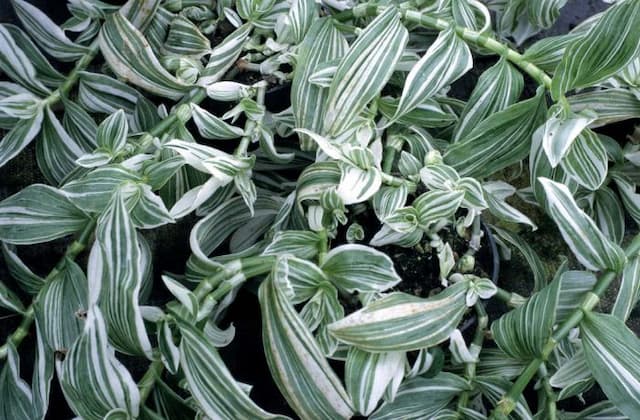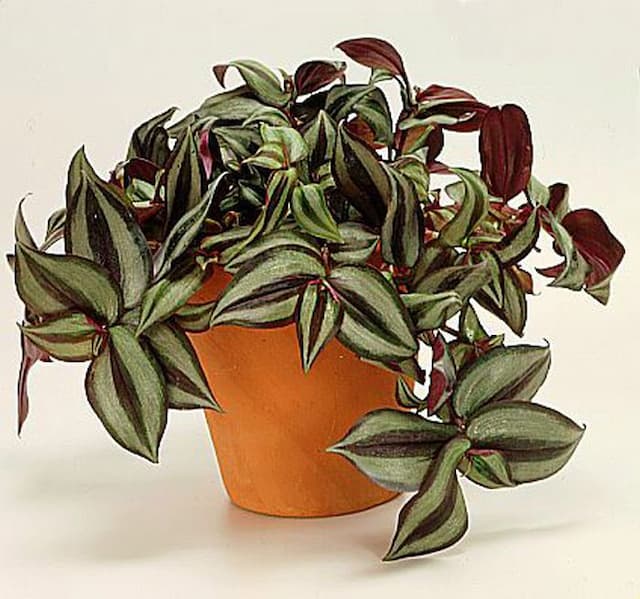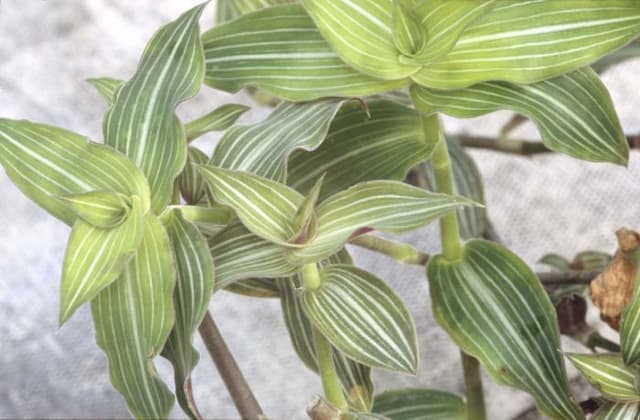Spiderwort Tradescantia (Andersoniana Group) 'Leonora'

ABOUT
Tradescantia 'Leonora', also commonly known as spiderwort, is a perennial plant that is valued for its distinctive appearance and adaptability to a variety of garden settings. This cultivar typically features a bushy and compact growth habit, presenting lush, strap-like leaves that create a grassy effect. The foliage is often a vibrant green color, setting a fresh backdrop for its blooms. The flowers of Tradescantia 'Leonora' are particularly striking, usually appearing in clusters. Each individual flower consists of three petals that can range in color from deep purple to bright blue, often with contrasting yellow stamens at the center that add to their ornamental appeal. These flowers are known for their iridescence and may have a shimmering quality when caught in the light. Bloom time for the 'Leonora' spiderwort is typically in the late spring to early summer, and under optimal conditions, it might repeat bloom into the early fall. The plant's flowers are fleeting, often opening in the morning and closing by the afternoon. However, the profusion of blooms and the plant's tendency to produce new flowers over an extended period ensure continuous color in the garden. In terms of its growth, spiderwort 'Leonora' is appreciated for its hardiness and resilience, often thriving with minimal care once established. It can serve as an excellent ground cover, adding texture, color, and interest to garden beds, borders, and naturalized areas. Spiderworts are also attractive to pollinators, making them a beneficial addition to wildlife or pollinator gardens. Overall, its appearance is a blend of wildflower charm and garden refinement, making it a favorite among garden enthusiasts.
About this plant
 Names
NamesFamily
Commelinaceae
Synonyms
Spiderwort, Widow's Tears
Common names
Tradescantia (Andersoniana Group) 'Leonora'.
 Toxicity
ToxicityTo humans
The Spiderwort plant is generally considered non-toxic to humans. However, as with any plant material, individual sensitivities can vary, and ingesting plant parts may cause mild stomach upset or allergic reactions in some people. The severity of symptoms can depend on the amount consumed and the sensitivity of the individual. It's always best to avoid ingesting plants that are not specifically grown for consumption.
To pets
The Spiderwort plant is generally considered non-toxic to both dogs and cats, making it a pet-friendly plant option. Despite this, pets might still experience mild gastrointestinal discomfort if they consume parts of the plant, so it is always advisable to keep an eye on your pets and prevent them from eating ornamental plants whenever possible.
 Characteristics
CharacteristicsLife cycle
Perennials
Foliage type
Deciduous
Color of leaves
Green
Flower color
Varies
Height
1-2 feet (30-60 cm)
Spread
1-2 feet (30-60 cm)
Plant type
Herb
Hardiness zones
4-9
Native area
North America
Benefits
 General Benefits
General Benefits- Easy to Grow: Tradescantia 'Leonora' is known for being easy to care for, which makes it suitable for gardeners of all skill levels.
- Decorative Foliage: The plant has attractive, variegated leaves that can add a decorative touch to gardens or indoor spaces.
- Drought Tolerant: Once established, it can tolerate periods of dryness, reducing the need for frequent watering.
- Pest Resistant: Traditionally, these plants have a resistance to many common pests, decreasing the need for chemical treatments.
- Rapid Growth: This cultivar often grows quickly, filling in garden spaces and creating groundcover more efficiently.
- Shade Tolerant: It has the ability to thrive in partial shade, providing flexibility in garden design and plant placement.
- Soil Adaptability: 'Leonora' can adapt to a wide range of soil types, although it prefers moist, well-drained conditions.
- Propagates Easily: The plant can be propagated easily from cuttings, allowing gardeners to multiply their plants without additional costs.
- Seasonal Flowers: The plant produces small, three-petaled flowers, typically in shades of pink or purple that provide a seasonal display of color.
- Borders and Edges: Tradescantia 'Leonora' works well for creating borders or edging pathways, giving a structured look to garden spaces.
- Compatibility: It plays well with other plants in mixed beds and containers, offering flexibility in landscape and garden design.
 Medical Properties
Medical PropertiesThis plant is not used for medical purposes.
 Air-purifying Qualities
Air-purifying QualitiesThis plant is not specifically known for air purifying qualities.
 Other Uses
Other Uses- Photography Backdrop: Its vibrant foliage can provide a lush green backdrop for close-up photographs of insects or other small subjects.
- Educational Tool: Tradescantia can be used in classrooms to teach students about plant biology and propagation techniques due to its ease of growth.
- Art Supplies: The sap from Tradescantia stems can be used to create a natural green pigment for painting or dyeing textiles.
- Floral Arrangements: Stems of Tradescantia can add a touch of purple and greenery to bouquets or table centerpieces.
- Color Changing Indicator: The leaves of some Tradescantia species can change color under different light conditions, which can be used to demonstrate light-dependent reactions in plants.
- Companion Planting: Tradescantia can be planted alongside vegetables to provide ground cover and reduce weed growth.
- Seasonal Decor: Cuttings of Tradescantia arranged in small pumpkins or gourds make for unique autumnal decorations.
- Fairy Gardens: Due to its small size and attractive leaves, Tradescantia can be incorporated into fairy garden designs.
- Cooking Garnishes: While not commonly eaten, the flowers of some Tradescantia species may be used as a decorative, edible garnish on salads or desserts.
- Seed Harvesting: Tradescantia can be grown for harvesting seeds, which can be used for further propagation or as a trade item among horticulture enthusiasts.
Interesting Facts
 Feng Shui
Feng ShuiThe Spiderwort is not used in Feng Shui practice.
 Zodiac Sign Compitability
Zodiac Sign CompitabilityThe Spiderwort is not used in astrology practice.
 Plant Symbolism
Plant Symbolism- Adaptability: Tradescantia, commonly known as Spiderwort, often symbolizes adaptability due to its ability to thrive in various conditions.
- Resilience: Spiderwort is known for its hardiness and resilience, often growing strongly even in challenging environments.
- Transience: The individual flowers of Spiderwort typically last for only one day, which has led to its association with the transient nature of life.
 Water
WaterThe Spiderwort prefers to be watered regularly but it’s important to let the soil dry out slightly between waterings. In general, water the plant about once a week, providing it with approximately 1 gallon of water each time, ensuring you water the soil rather than the leaves to avoid leaf rot. The amount of water may vary depending on the humidity and temperature, so it's important to check the soil moisture. During the winter months, reduce the frequency as the plant’s water requirements decrease. Always use room temperature water to avoid shocking the plant’s roots.
 Light
LightSpiderwort thrives in bright, indirect sunlight. It is best to place it in a spot where it will receive morning sunlight and shade during the hot afternoon hours. Direct sunlight can scorch the leaves, while too little light can cause leggy growth. A north or east-facing window would be an ideal location for optimal light conditions.
 Temperature
TemperatureSpiderwort prefers temperatures between 60 to 80 degrees Fahrenheit. It can survive minimum temperatures down to around 50 degrees Fahrenheit but will not do well if the temperature drops below this. Keep the plant away from drafts and air vents, as sudden changes in temperature can be harmful.
 Pruning
PruningPruning Spiderwort is beneficial for promoting bushier growth and preventing it from becoming leggy. Prune in the spring by cutting back the stems to encourage fuller growth. Regularly removing faded flowers can also promote continuous blooming. Pruning is typically done once a year but check for dead or damaged stems throughout the year to remove as necessary.
 Cleaning
CleaningAs needed
 Soil
SoilSpiderwort 'Leonora' thrives in moist, well-draining soil with a pH of 5.5 to 6.5. A mix of loamy soil, peat, perlite, and compost is ideal to ensure proper drainage and nutrient availability.
 Repotting
RepottingSpiderwort 'Leonora' should be repotted every 2 to 3 years, or when it becomes root-bound. Spring is the best time to repot to minimize stress on the plant.
 Humidity & Misting
Humidity & MistingSpiderwort 'Leonora' prefers moderate to high humidity levels, ideally between 40% and 60%. Avoid overly dry conditions, which can lead to brown leaf tips.
 Suitable locations
Suitable locationsIndoor
Provide bright, indirect light and keep moist.
Outdoor
Plant in partial shade, water regularly, and protect from frost.
Hardiness zone
4-9 USDA
 Life cycle
Life cycleTradescantia 'Leonora', commonly known as Spiderwort, begins its life as a seed which upon germination develops into a seedling with thin grass-like leaves. As it matures, the plant forms a clump of long, blade-like leaves that are green to green-and-white striped. Spiderwort enters a vegetative growth stage where it continues to grow in size and foliage density, during which underground rhizomes may spread to form new shoots. In late spring to early summer, the plant produces small, three-petaled flowers that range in color from blue to purple, which typically bloom for a day before closing and eventually falling off. After flowering, the plant may produce seeds if pollination has occurred, allowing for self-propagation, or it can be propagated vegetatively by division. Lastly, Spiderwort is a perennial plant, meaning after the flowering season, it will enter a dormant stage in the fall and winter and regrow the following spring from the existing root system or the rhizomes.
 Propogation
PropogationPropogation time
Spring-Early Summer
Propogation: The Tradescantia (Andersoniana Group) 'Leonora', commonly known as Spiderwort, can be easily propagated through division, which is the most popular method among gardeners. The optimal time for propagation by division is in early spring or fall when the plant is not in active bloom. To propagate Spiderwort by division, dig up the plant gently, making sure to keep a good amount of the root system intact with each section. Next, separate the clump into smaller divisions, each containing several growth points. These divisions can then be re-planted immediately into prepared garden soil or pots, ensuring that the crown of the plant is just at or slightly below the soil level. Water the newly planted divisions thoroughly to help establish them. This technique is straightforward and helps to rejuvenate older clumps that may have become less vigorous, as well as to increase the number of plants.



